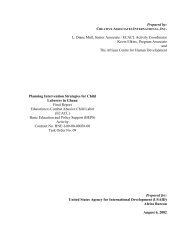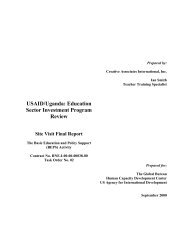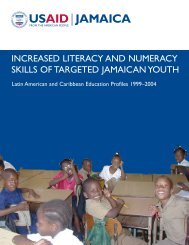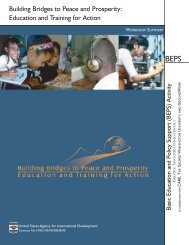Grandmothers: A Learning Institution - Basic Education and Policy ...
Grandmothers: A Learning Institution - Basic Education and Policy ...
Grandmothers: A Learning Institution - Basic Education and Policy ...
- No tags were found...
You also want an ePaper? Increase the reach of your titles
YUMPU automatically turns print PDFs into web optimized ePapers that Google loves.
was conducted in the Kumasi area (Daviset al. 2003). Similar to the Linkages studyresults, it was found that gr<strong>and</strong>mothersmost frequently assume the role of “caretaker”when the mothers are occupiedwith other tasks, with husb<strong>and</strong>s being thesecond most common caretakers.Similarly, in a third study, with women inpaid employment (Date-Bah 1985), it wasfound that the maternal gr<strong>and</strong>mother wasthe most common caretaker when womenwere away at work.Lesotho: A study on breastfeedingrevealed that gr<strong>and</strong>mothers’ traditionbasedadvice <strong>and</strong> practices related tobreastfeeding is often superior to theadvice given by health clinic staff (Almrothet al. 1997). <strong>Gr<strong>and</strong>mothers</strong>’ were adamantthat it is harmful <strong>and</strong> unnecessary to givewater to breastfeeding infants during theirfirst months of life. The gr<strong>and</strong>mothers’maintained that this harmful practice camefrom health workers, thus providing advicethat is both harmful <strong>and</strong> contradicts thegr<strong>and</strong>mothers’ views. The authors concludedthat gr<strong>and</strong>mothers’ good adviceshould be shared with both youngermothers <strong>and</strong> health workers.South Africa: It is often assumed thatyoung women have full responsibility forchildcare <strong>and</strong> for decision-making on theuse of family resources. A study in Natalprovince (Chopra 2003) illuminates thesetwo critical dimensions of gr<strong>and</strong>mothers’influence in the household. It showed thatapproximately the same percentage ofyoung children (3 to 59 months) are caredfor by their gr<strong>and</strong>mothers (39 percent) asby their own mothers (41 percent), clearlysuggesting the importance of the child-carerole of gr<strong>and</strong>mothers in this setting.Regarding household decision-making, thestudy also showed that while more thanhalf of the younger women (57 percent)decide how much will be spent on foodfor the family, in almost a quarter of thefamilies it is the gr<strong>and</strong>mother who makesthese decisions (23 percent), while in onlyl6 percent does the husb<strong>and</strong> decide.Nigeria: A study on breastfeeding amongrural Yoruba in Southwest Nigeria documentedthe significant influence of olderwomen on younger women’s breastfeedingpractices from the first moments afterbirth (Davies-Adetugbo 1997). Whilethese experienced women strongly promotebreastfeeding, some of their advice isbeneficial <strong>and</strong> some is not. Immediatelyafter birth the older women who are tocare for the newborn <strong>and</strong> mother carryout a series of ritual-bound practices,decreasing the likelihood that the baby willbe breastfed in the first half hour as healthworkers recommend. Most of thembelieve that colostrum should not be givento the newborn, that medicinal herbsshould be administered “to clean out thestomach,” <strong>and</strong> that, during the first weeks<strong>and</strong> months of life, infants require supplementalwater along with breast milk. Onthe other h<strong>and</strong>, they give good advice tobreastfeeding women regarding their diet<strong>and</strong> most are vehemently opposed toinfant feedingMalawi: In a rapid assessment of roles <strong>and</strong>practices related to newborn care, in thecontext of work by Save the Children/US,the role of gr<strong>and</strong>mothers at this criticalperiod was clearly documented(Waltensperger 2001b). Whether in62 UNITED STATES AGENCY FOR INTERNATIONAL DEVELOPMENT







